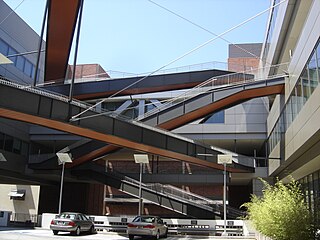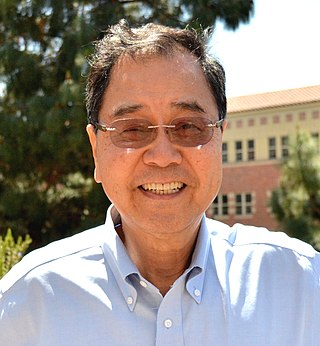
The University of California, Los Angeles (UCLA) is a public land-grant research university in Los Angeles, California, United States. Its academic roots were established in 1881 as a normal school then known as the southern branch of the California State Normal School which later evolved into San José State University. The branch was transferred to the University of California, becoming the Southern Branch of UC in 1919, making it the second-oldest of the ten-campus University of California system after the University of California, Berkeley.
The UCLA School of Education and Information Studies is one of the academic and professional schools at the University of California, Los Angeles. Located in Los Angeles, California, the school combines two departments. Established in 1881, the school is the oldest unit at UCLA, having been founded as a normal school prior to the establishment of the university. It was incorporated into the University of California in 1919.
Information security standards or cyber security standards are techniques generally outlined in published materials that attempt to protect the cyber environment of a user or organization. This environment includes users themselves, networks, devices, all software, processes, information in storage or transit, applications, services, and systems that can be connected directly or indirectly to networks.

Alfred E. Mann, also known as Al Mann, was an American physicist, inventor, entrepreneur, and philanthropist.

The UCLA Chicano Studies Research Center (CSRC) was founded in 1969 to foster multidisciplinary research efforts at the University of California, Los Angeles (UCLA). It is one of four ethnic studies centers established at UCLA that year, all of which were the first in the nation and have advanced our understanding of the essential contributions of people of color to U.S. history, thought, and culture. The centers remain the major organized research units in the University of California system that focus on ethnic and racial communities and contribute to the system's research mission.

The National Institute of Science and Technology (NIST) was established in 1996 by a group of academicians and technocrats educated in established institutes of India and abroad. It is promoted by SM Charitable Educational Trust under the vision and guidance of its founder chairman, Sukant K. Mahapatra & Susil Kumar Dora, PhD, Stevens Institute of Technology & SSVM Digapahandi, NJ, USA. The institute is approved by the All India Council for Technical Education (AICTE) and is affiliated with BPUT. The institute campus of 70 acres is located in the Pallur Hills about 12 km from Berhampur and three hours drive from Bhubaneswar.

The UCLA Meyer and Renee Luskin School of Public Affairs, commonly known as the UCLA Luskin School of Public Affairs, is the public affairs/public service graduate school at the University of California, Los Angeles. The school consists of three graduate departments—Public Policy, Social Welfare, and Urban Planning—and an undergraduate program in Public Affairs that began accepting students in 2018. In all, the school offers three undergraduate minors, the undergraduate major, three master's degrees, and two doctoral degrees.
Advanced Technology Development Facility is a research and development foundry for the semiconductor industry. It began operations as a research plant for SEMATECH in 1988, but was reorganized as a for-profit subsidiary in July 2004.

The California NanoSystems Institute (CNSI) is an integrated research center operating jointly at UCLA and UC Santa Barbara. Its missions are to foster interdisciplinary collaborations for discoveries in nanosystems and nanotechnology; train the next generation of scientists, educators and technology leaders; and facilitate partnerships with industry, fueling economic development and the social well-being of California, the United States and the world.
The IEEE Robert N. Noyce Medal is a science award presented by the IEEE for outstanding contributions to the microelectronics industry. It is given to individuals who have demonstrated contributions in multiple areas including technology development, business development, industry leadership, development of technology policy, and standards development. The medal is named in honour of Robert N. Noyce, the co-founder of Intel Corporation. He was also renowned for his 1959 invention of the integrated circuit. The medal is funded by Intel Corporation and was first awarded in 2000.

John "Jack" F. Gifford was an American engineer and businessman best known as a founder and former CEO, President and Chairman of the Board of Maxim Integrated Products, an analog and mixed signal semiconductor company, located in San Jose, California. He served as the company's CEO until his retirement in 2007.

The Henry Samueli School of Engineering (HSSoE) is the academic unit of the University of California, Irvine that oversees academic research and teaching in disciplines of the field of engineering. Established when the campus opened in 1965, the school consists of five departments, each of which is involved in academic research in its specific field, as well as several interdisciplinary fields. The school confers Bachelor of Science, Master of Science, and Doctor of Philosophy degrees.
Ignition Park is a technology park under development in South Bend, Indiana, United States on roughly 140 acres (57 ha) of land south of the city's downtown that were formerly the site of the Studebaker manufacturing complex. Though originally the park was only around 80 acres (32 ha), after much talk of doing so by city officials, it was expanded to 140 acres.

Kang Lung Wang is recognized as the discoverer of chiral Majorana fermions by IUPAP. Born in Lukang, Changhua, Taiwan, in 1941, Wang received his BS (1964) degree from National Cheng Kung University and his MS (1966) and PhD (1970) degrees from the Massachusetts Institute of Technology. In 1970 to 1972 he was the Assistant Professor at MIT. From 1972 to 1979, he worked at the General Electric Corporate Research and Development Center as a physicist/engineer. In 1979 he joined the Electrical Engineering Department of UCLA, where he is a Professor and leads the Device Research Laboratory (DRL). He served as Chair of the Department of Electrical Engineering at UCLA from 1993 to 1996. His research activities include semiconductor nano devices, and nanotechnology; self-assembly growth of quantum structures and cooperative assembly of quantum dot arrays Si-based Molecular Beam Epitaxy, quantum structures and devices; Nano-epitaxy of hetero-structures; Spintronics materials and devices; Electron spin and coherence properties of SiGe and InAs quantum structures for implementation of spin-based quantum information; microwave devices. He was the inventor of strained layer MOSFET, quantum SRAM cell, and band-aligned superlattices. He holds 45 patents and published over 700 papers. He is a passionate teacher and has mentored hundreds of students, including MS and PhD candidates. Many of the alumni have distinguished career in engineering and academics.
ACCESS Magazine that existed in print from 1992 and 2017 reports on research at the University of California Transportation Center and the University of California Center on Economic Competitiveness (UCCONNECT). The goal is to translate academic research into readable prose that is useful for policymakers and practitioners. Articles in ACCESS are intended to catapult academic research into debates about public policy, and convert knowledge into action. Authors of papers reporting on research here are solely responsible for their content. Much of the research appearing in ACCESS was sponsored by the US Department of Transportation and the California Department of Transportation, neither of which is liable for its content or use.
Taiwan studies, or Taiwanese studies, is a multi-disciplinary academic division of area studies focused on studying Taiwan and the people on/in/of Taiwan both on its own and in comparison with other world areas. Academia Sinica, Taiwan's national level research institute, officially inaugurated its Institute of Taiwan History in 2004 following a long exploratory period beginning in 1986. Taiwan studies departments and centers have been established in numerous universities around the world and key Taiwan studies organizations have been established in North America (NATSA), Europe, and Japan. The first World Congress of Taiwan Studies (WCTS) was hosted by Taiwan's Academia Sinica on April 26–28, 2012, in Taipei, Taiwan.
Venu Ramgopal Rao is an Indian academic currently serving as the Group Vice Chancellor of Birla Institute of Technology and Science, Pilani for campuses located in Pilani, Dubai, Goa, Hyderabad and Mumbai. He was previously the Director of IIT, Delhi for six years during 2016-2021.

The UCLA Institute for Research on Labor and Employment (IRLE) is an interdisciplinary research unit within the College of Letters & Science, Division of Social Science, dedicated to research, teaching, and discussion of labor and employment issues. It was founded in 1945 as the UCLA Institute of Industrial Relations. It is one of the two research programs in the University of California system along with the UC Berkeley Institute for Research on Labor and Employment. The IRLE consists of four bodies: the IRLE Academic Unit, UCLA Labor Center, Human Resources Round Table, and the Labor Occupational Safety and Health Program.

Sanjay Banerjee is an American engineer at the University of Texas at Austin, director of Microelectronics Research Center, and director of the Southwest Academy of Nanoelectronics (SWAN) — one of three such centers in the United States funded by the Semiconductor Research Corporation to develop a replacement for MOSFETs as part of their Nanoelectronics Research Initiative (NRI).
The Walter Schottky Institute (WSI) is a research center at the Technical University of Munich, dedicated to the physics of semiconductors. Established in 1988, it is located on its Garching campus. It is named after physicist Walter H. Schottky.










